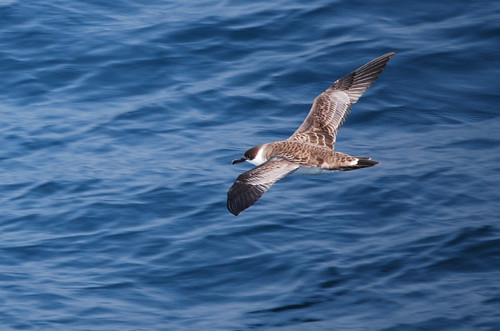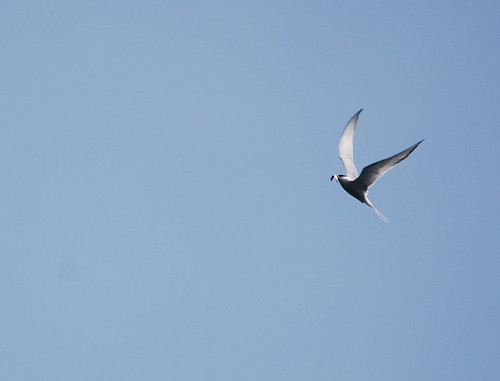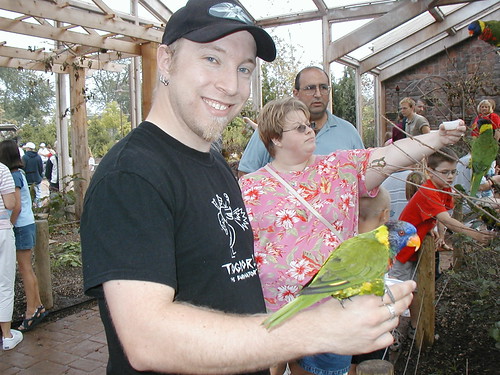So, latest life bird was a Lark Sparrow, possibly two, that I observed on my way home from work Thursday before leaving for Atlanta to move the rest of my wife's possessions to our new home.
The birds were reported to be hanging out in a scrubby area near a Lowe's hardware store in south Columbus, near a seasonal wetland. I heard one singing, and caught a glimpse of a juvenile bird skulking about in some weeds. It's possible they bred here, but they could also be early migrants. In any case, Lark Sparrows in Columbus is almost unheard of.
The day after I saw them, some other folks went there and saw one bird, but then confirmed breeding Blue Grosbeaks, which is also unheard of for Columbus. So the moral is: check those vacant lots!
Tuesday, July 31, 2007
Monday, July 23, 2007
Answer to the last blog post title: Do Both!
So, saturday morning after a very nice breakfast of pancakes with Maine blueberry syrup lovingly prepared by my wife, I headed down to Logan, Ohio, to look for the Mississippi Kite.
I arrived at the Brass Circle golf course about 10:30 am and parked at the end of the course. About 10:40 AM, I observed one kite being harassed by two smaller (unidentified) birds, before it ducked down below the tree line. I saw it (or the other one, there's two and they are almost certainly breeding) again a few minutes later. And voila, that's number 362 on my life list and number 277 on my Ohio list.
Satisfied, I headed back up to Columbus, listening to my favorite radio show "Wait, Wait, Don't Tell Me - The NPR News Quiz" which is one of the funniest news commentary shows in all of media.
I went up to Sharon Woods Metro Park, which is in one of my atlas blocks. Although breeding season is coming to an end, there were still a lot of birds with recently fledged young - some that were so close to adult plumage that behavior was the main indication of a juvenile instead of an adult. I added the following confirmations for block 58D2NW: Blue-Gray Gnatcatcher, Cedar Waxwing, Eastern Kingbird, Brown-headed Cowbird, Blue Jay, Tufted Titmouse, Northern Mockingbird. I also updated Common Yellowthroat to a T7 code. This will probably be my last set of OBBA observations for this season, as household duties will keep me out of the field for the next couple of weeks.
But then it's shorebird season!
I arrived at the Brass Circle golf course about 10:30 am and parked at the end of the course. About 10:40 AM, I observed one kite being harassed by two smaller (unidentified) birds, before it ducked down below the tree line. I saw it (or the other one, there's two and they are almost certainly breeding) again a few minutes later. And voila, that's number 362 on my life list and number 277 on my Ohio list.
Satisfied, I headed back up to Columbus, listening to my favorite radio show "Wait, Wait, Don't Tell Me - The NPR News Quiz" which is one of the funniest news commentary shows in all of media.
I went up to Sharon Woods Metro Park, which is in one of my atlas blocks. Although breeding season is coming to an end, there were still a lot of birds with recently fledged young - some that were so close to adult plumage that behavior was the main indication of a juvenile instead of an adult. I added the following confirmations for block 58D2NW: Blue-Gray Gnatcatcher, Cedar Waxwing, Eastern Kingbird, Brown-headed Cowbird, Blue Jay, Tufted Titmouse, Northern Mockingbird. I also updated Common Yellowthroat to a T7 code. This will probably be my last set of OBBA observations for this season, as household duties will keep me out of the field for the next couple of weeks.
But then it's shorebird season!
Wednesday, July 18, 2007
Life bird or breeding bird survey? That is the question
so, Saturday I will go birding again. I have only been birding once since I got back from my honeymoon, due to household commitments. I've been reading on Ohio-birds about two species of birds currently being seen in Ohio that aren't native to the state (not yet, anyway), and I want to see at least one of these birds: Mississippi Kite in Logan, Ohio; and Eurasian Collared-dove in Celia, Ohio. Seeing either would add another life bird to my list.
However, I also should put in some time for the breeding bird atlas, as I have 3 blocks I have signed up for and it's near the end of the season. What to do?
Also on Saturday, my wife E. B. is cooking pancakes for breakfast. That sort of rules out the survey option. I think I will go for one of the potential life birds, then maybe get up early Sunday morning and do some work in my newest survey block.
The thing about my new survey block, is that I didn't realize how urban and blighted it is when I signed up for it. I asked for it because it is a "priority block" - that is, it's a block that was surveyed during the first atlas in the 1980s and they want all priority blocks surveyed to ensure comparative data. The list of birds from the 80s survey seems amazingly diverse for how the area looks now - mainly neighborhoods of closely packed houses of low-income families. One park has a decent woodlot, but I am pretty unsure of the safety of bushwacking through these woods by myself in this location. There is also a public golf course, and next season I will ask permission to survey on its property. American Kestrel and Wood duck were confirmed breeders in the 80s in this block, and if they are going to be present now, that's probably where they will be.
However, I also should put in some time for the breeding bird atlas, as I have 3 blocks I have signed up for and it's near the end of the season. What to do?
Also on Saturday, my wife E. B. is cooking pancakes for breakfast. That sort of rules out the survey option. I think I will go for one of the potential life birds, then maybe get up early Sunday morning and do some work in my newest survey block.
The thing about my new survey block, is that I didn't realize how urban and blighted it is when I signed up for it. I asked for it because it is a "priority block" - that is, it's a block that was surveyed during the first atlas in the 1980s and they want all priority blocks surveyed to ensure comparative data. The list of birds from the 80s survey seems amazingly diverse for how the area looks now - mainly neighborhoods of closely packed houses of low-income families. One park has a decent woodlot, but I am pretty unsure of the safety of bushwacking through these woods by myself in this location. There is also a public golf course, and next season I will ask permission to survey on its property. American Kestrel and Wood duck were confirmed breeders in the 80s in this block, and if they are going to be present now, that's probably where they will be.
Thursday, July 12, 2007
Thoughts on Maine birding
While the main reason I spent a week on Mount Desert Island in Maine was not birding, but honeymooning, I still paid attention to bird life. Here's a few of the things that really stood out to me, a Midwestern birder.
I think the first thing I noticed was the regional difference in the songs of Song Sparrows. I was awoken on the first morning on the island by one outside the window of our cottage, about 4:30 am. At first, I had no idea what it was, but after listening for a while, I thought that while the pattern wasn't the same as Midwestern sparrows, the timbre of the song was pretty much the same. Later, I saw a Song Sparrow singing this song, which clinched it.
Another thing was of course all the breeding warblers, especially the Black-throated Green Warblers which seemed to be everywhere. Northern Parulas and Ovenbirds were also pretty common, as well as Yellow Warblers.
What wasn't very diverse were ducks and raptors. I had two species of each: Common Eider and Mallard for ducks, Osprey and Bald Eagle for raptors. I saw no hawks of any sort while on the island, not even a Red-tailed Hawk.
It was also interesting to not have Ring-billed gulls around. I'm used to the Great Lakes, where they are the most common gull. Instead, Herring Gulls and Great Black Backed gulls were the norm.
Sparrows, besides the Song Sparrows, included Eastern Towhee, Dark-eyed Junco and White-throated Sparrow.
All in all, it was pretty good birding, with 70 species for the whole trip, including the seabirds I posted about earlier.
I think the first thing I noticed was the regional difference in the songs of Song Sparrows. I was awoken on the first morning on the island by one outside the window of our cottage, about 4:30 am. At first, I had no idea what it was, but after listening for a while, I thought that while the pattern wasn't the same as Midwestern sparrows, the timbre of the song was pretty much the same. Later, I saw a Song Sparrow singing this song, which clinched it.
Another thing was of course all the breeding warblers, especially the Black-throated Green Warblers which seemed to be everywhere. Northern Parulas and Ovenbirds were also pretty common, as well as Yellow Warblers.
What wasn't very diverse were ducks and raptors. I had two species of each: Common Eider and Mallard for ducks, Osprey and Bald Eagle for raptors. I saw no hawks of any sort while on the island, not even a Red-tailed Hawk.
It was also interesting to not have Ring-billed gulls around. I'm used to the Great Lakes, where they are the most common gull. Instead, Herring Gulls and Great Black Backed gulls were the norm.
Sparrows, besides the Song Sparrows, included Eastern Towhee, Dark-eyed Junco and White-throated Sparrow.
All in all, it was pretty good birding, with 70 species for the whole trip, including the seabirds I posted about earlier.
Wednesday, July 11, 2007
Monday, July 9, 2007
Back again - brief post
I'm back in town from my three-week wedding/honeymoon/vacation blitz.
This will be a brief update on my birding in Maine, with pictures to come soon.
The best birding was the whale watching trip, which nabbed me 8 life birds - Atlantic Puffin, Razorbill, Common Murre, Arctic Tern, Greater Shearwater, Sooty Shearwater, Wilson's Storm-petrel, and Northern Fulmar. I also added Black Guillemot to my list the day before the whale watching trip, for a total of nine life birds (bringing my life list up to 361). We also saw finback and humpback whales and harbor seals.
The land birding was also good, although I only got about 2 hours of serious, stand-alone birding on Mount Desert Isle. The rest of my birding was done on an"as-encountered" basis. I notched up 70 species in 5 days of casual observation, which isn't bad.
More later when I get my photos online.
This will be a brief update on my birding in Maine, with pictures to come soon.
The best birding was the whale watching trip, which nabbed me 8 life birds - Atlantic Puffin, Razorbill, Common Murre, Arctic Tern, Greater Shearwater, Sooty Shearwater, Wilson's Storm-petrel, and Northern Fulmar. I also added Black Guillemot to my list the day before the whale watching trip, for a total of nine life birds (bringing my life list up to 361). We also saw finback and humpback whales and harbor seals.
The land birding was also good, although I only got about 2 hours of serious, stand-alone birding on Mount Desert Isle. The rest of my birding was done on an"as-encountered" basis. I notched up 70 species in 5 days of casual observation, which isn't bad.
More later when I get my photos online.
Subscribe to:
Posts (Atom)








